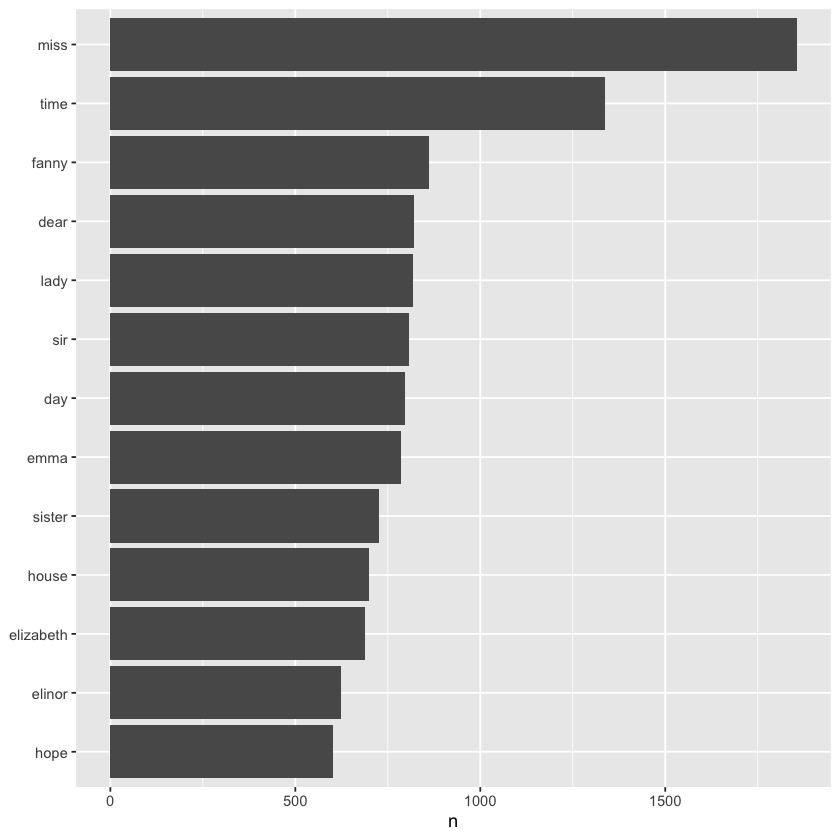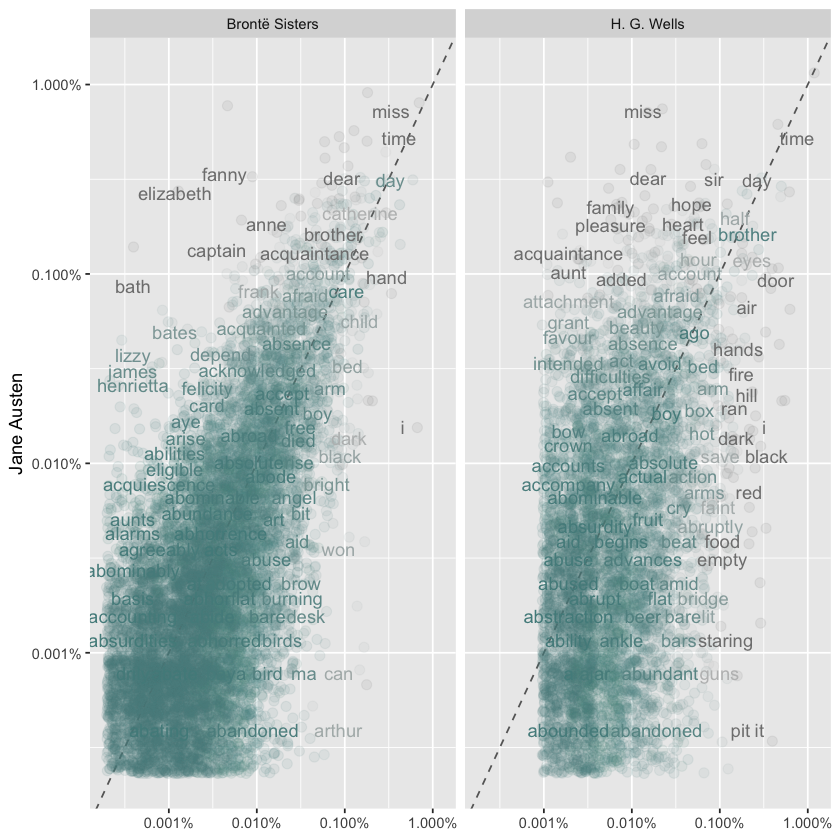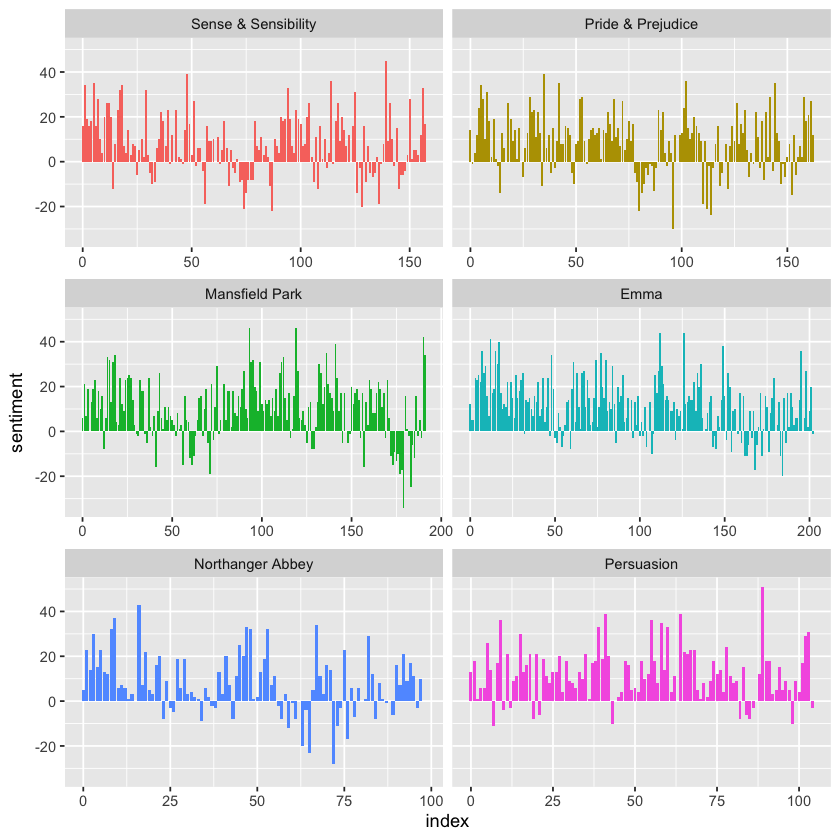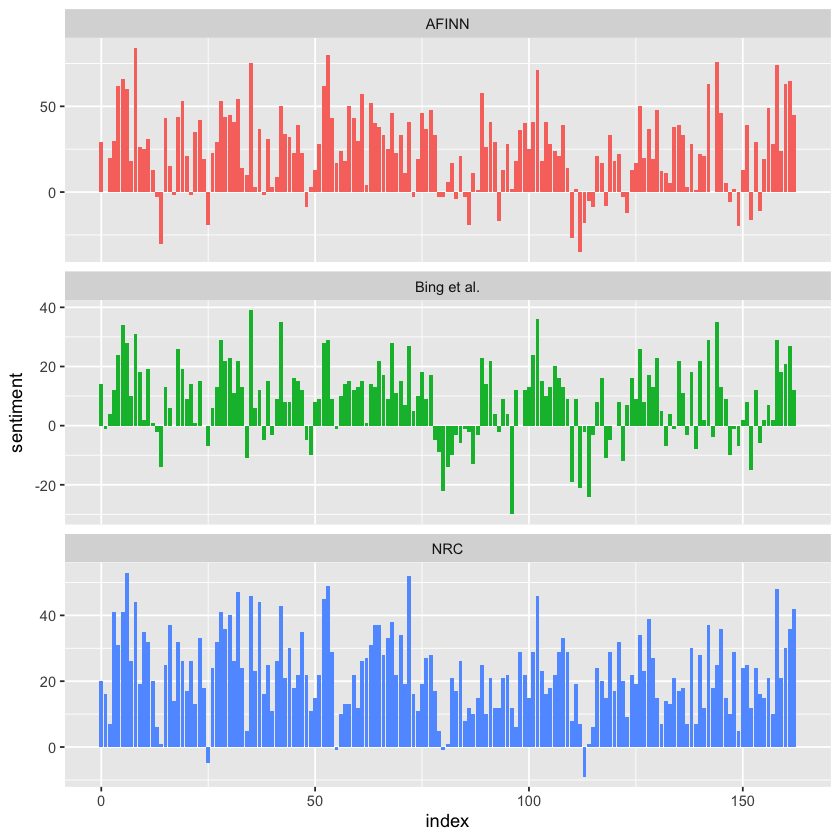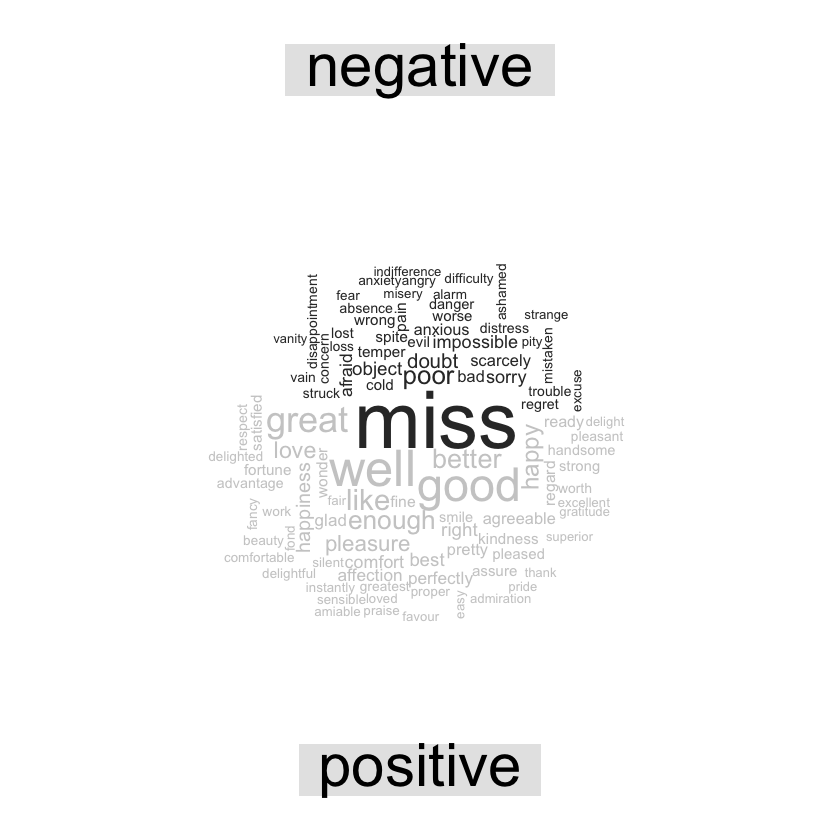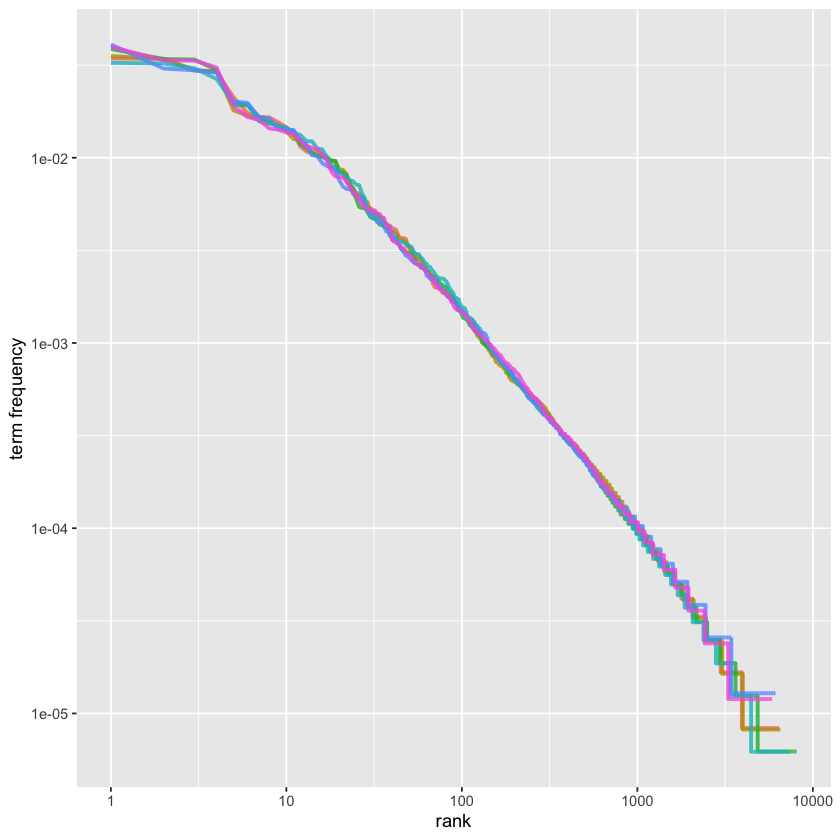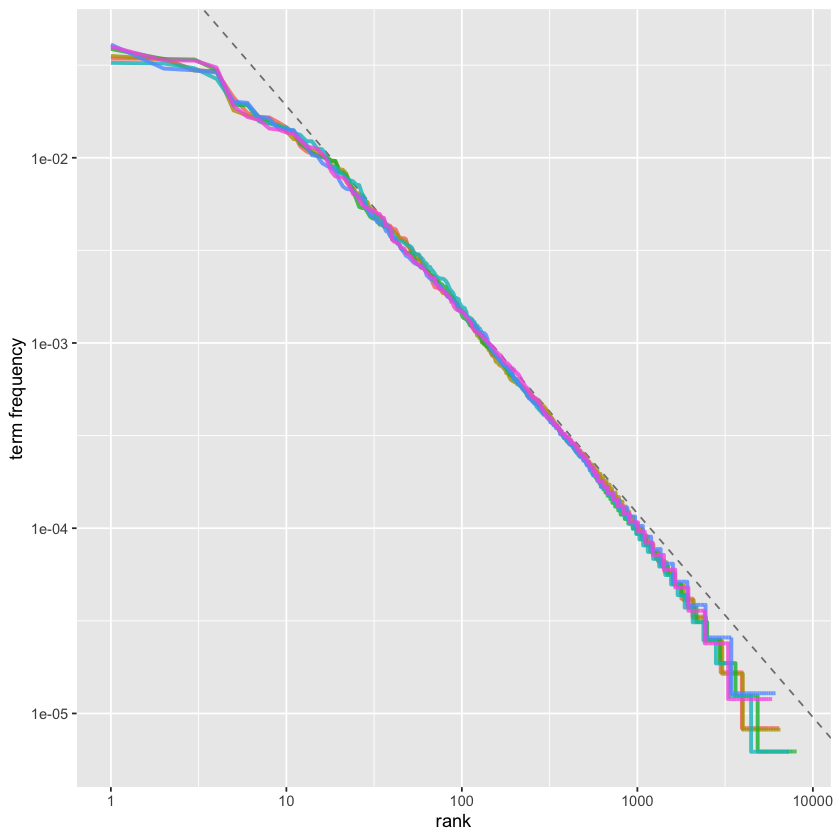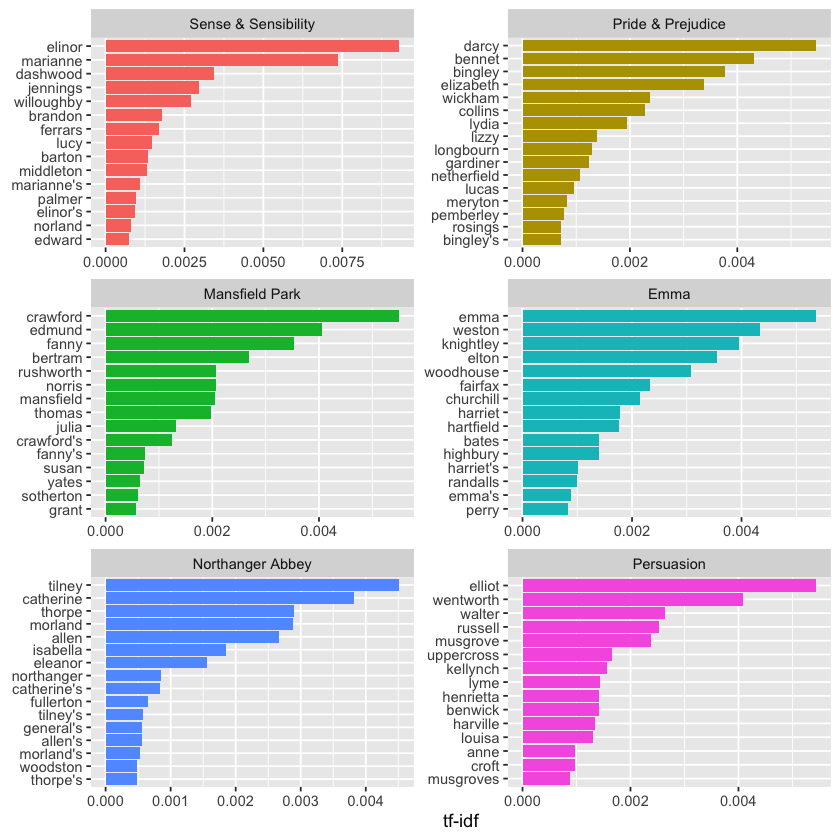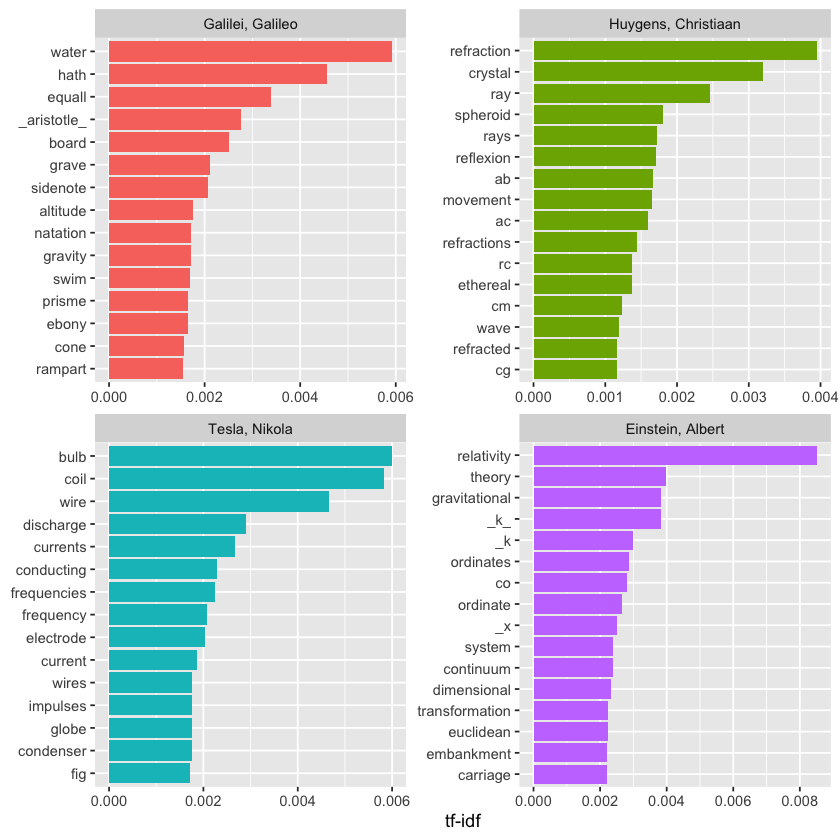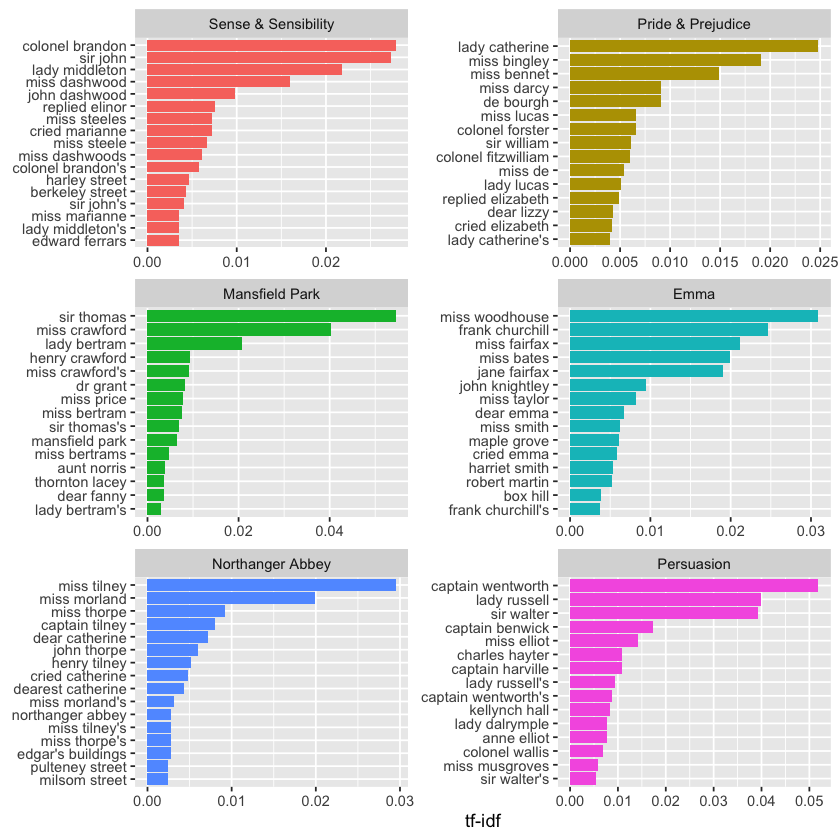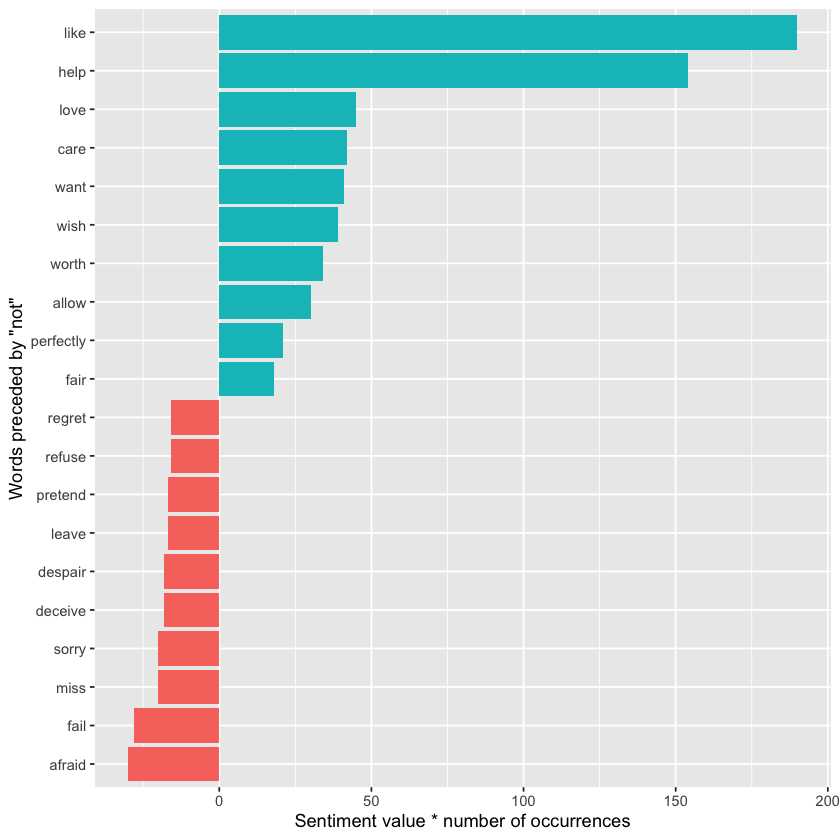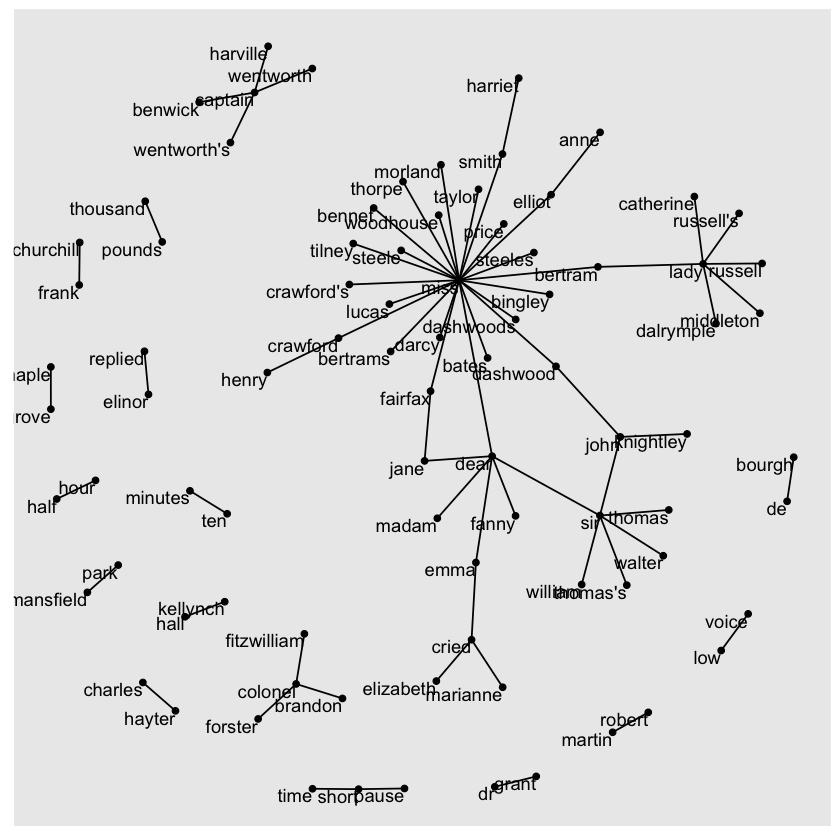Silge & Robinson’s Text Mining with R#
Silge, Julia & David Robinson. Text Mining with R: A Tidy Approach. O’Reilly. Home.
Programming Environment#
base::library(package = forcats)
base::library(package = ggraph)
base::library(package = gutenbergr)
base::library(package = janeaustenr)
base::library(package = reshape2)
base::library(package = scales)
base::library(package = tidytext)
base::library(package = tidyverse)
base::library(package = widyr)
base::library(package = wordcloud)
utils::sessionInfo()
Loading required package: ggplot2
── Attaching core tidyverse packages ───────────────────────────────────────────────────────────────────────────────────────────────────────────────────────────────────────────────────────────────────────────────────────────── tidyverse 2.0.0 ──
✔ dplyr 1.1.2 ✔ stringr 1.5.0
✔ lubridate 1.9.2 ✔ tibble 3.2.1
✔ purrr 1.0.2 ✔ tidyr 1.3.0
✔ readr 2.1.4
── Conflicts ─────────────────────────────────────────────────────────────────────────────────────────────────────────────────────────────────────────────────────────────────────────────────────────────────────────────── tidyverse_conflicts() ──
✖ readr::col_factor() masks scales::col_factor()
✖ purrr::discard() masks scales::discard()
✖ dplyr::filter() masks stats::filter()
✖ dplyr::lag() masks stats::lag()
ℹ Use the conflicted package (<http://conflicted.r-lib.org/>) to force all conflicts to become errors
Loading required package: RColorBrewer
R version 4.3.0 (2023-04-21)
Platform: aarch64-apple-darwin20 (64-bit)
Running under: macOS 14.4.1
Matrix products: default
BLAS: /Library/Frameworks/R.framework/Versions/4.3-arm64/Resources/lib/libRblas.0.dylib
LAPACK: /Library/Frameworks/R.framework/Versions/4.3-arm64/Resources/lib/libRlapack.dylib; LAPACK version 3.11.0
locale:
[1] en_US.UTF-8/en_US.UTF-8/en_US.UTF-8/C/en_US.UTF-8/en_US.UTF-8
time zone: America/New_York
tzcode source: internal
attached base packages:
[1] stats graphics grDevices utils datasets methods base
other attached packages:
[1] wordcloud_2.6 RColorBrewer_1.1-3 widyr_0.1.5 lubridate_1.9.2
[5] stringr_1.5.0 dplyr_1.1.2 purrr_1.0.2 readr_2.1.4
[9] tidyr_1.3.0 tibble_3.2.1 tidyverse_2.0.0 tidytext_0.4.1
[13] scales_1.2.1 reshape2_1.4.4 janeaustenr_1.0.0 gutenbergr_0.2.3
[17] ggraph_2.1.0 ggplot2_3.4.3 forcats_1.0.0
loaded via a namespace (and not attached):
[1] gtable_0.3.3 ggrepel_0.9.3 lattice_0.21-8 tzdb_0.4.0
[5] vctrs_0.6.3 tools_4.3.0 generics_0.1.3 fansi_1.0.4
[9] pkgconfig_2.0.3 tokenizers_0.3.0 Matrix_1.5-4 uuid_1.1-0
[13] lifecycle_1.0.3 compiler_4.3.0 farver_2.1.1 munsell_0.5.0
[17] ggforce_0.4.1 repr_1.1.6 graphlayouts_1.0.0 htmltools_0.5.5
[21] SnowballC_0.7.1 pillar_1.9.0 crayon_1.5.2 MASS_7.3-58.4
[25] viridis_0.6.3 tidyselect_1.2.0 digest_0.6.31 stringi_1.7.12
[29] polyclip_1.10-4 fastmap_1.1.1 grid_4.3.0 colorspace_2.1-0
[33] cli_3.6.1 magrittr_2.0.3 base64enc_0.1-3 tidygraph_1.2.3
[37] utf8_1.2.3 IRdisplay_1.1 broom_1.0.5 withr_2.5.0
[41] backports_1.4.1 IRkernel_1.3.2 timechange_0.2.0 igraph_1.5.0
[45] gridExtra_2.3 pbdZMQ_0.3-9 hms_1.1.3 evaluate_0.21
[49] viridisLite_0.4.2 rlang_1.1.1 Rcpp_1.0.10 glue_1.6.2
[53] tweenr_2.0.2 jsonlite_1.8.5 R6_2.5.1 plyr_1.8.8
1 - The tidy text format#
text <- c('Because I could not stop for Death -',
'He kindly stopped for me -',
'The Carriage held but just Ourselves -',
'and Immortality')
base::print(text)
[1] "Because I could not stop for Death -"
[2] "He kindly stopped for me -"
[3] "The Carriage held but just Ourselves -"
[4] "and Immortality"
text_df <- tibble::tibble(line = 1:4, text = text)
text_df
| line | text |
|---|---|
| <int> | <chr> |
| 1 | Because I could not stop for Death - |
| 2 | He kindly stopped for me - |
| 3 | The Carriage held but just Ourselves - |
| 4 | and Immortality |
text_df %>%
tidytext::unnest_tokens(output = word, input = text, to_lower = TRUE)
| line | word |
|---|---|
| <int> | <chr> |
| 1 | because |
| 1 | i |
| 1 | could |
| 1 | not |
| 1 | stop |
| 1 | for |
| 1 | death |
| 2 | he |
| 2 | kindly |
| 2 | stopped |
| 2 | for |
| 2 | me |
| 3 | the |
| 3 | carriage |
| 3 | held |
| 3 | but |
| 3 | just |
| 3 | ourselves |
| 4 | and |
| 4 | immortality |
original_books <- janeaustenr::austen_books() %>%
dplyr::group_by(book) %>%
dplyr::mutate(linenumber = dplyr::row_number(),
chapter = base::cumsum(stringr::str_detect(string = text,
pattern = stringr::regex(pattern = '^chapter [\\divxlc]',
ignore_case = TRUE)))) %>%
dplyr::ungroup()
head(original_books)
| text | book | linenumber | chapter |
|---|---|---|---|
| <chr> | <fct> | <int> | <int> |
| SENSE AND SENSIBILITY | Sense & Sensibility | 1 | 0 |
| Sense & Sensibility | 2 | 0 | |
| by Jane Austen | Sense & Sensibility | 3 | 0 |
| Sense & Sensibility | 4 | 0 | |
| (1811) | Sense & Sensibility | 5 | 0 |
| Sense & Sensibility | 6 | 0 |
tidy_books <-
original_books %>%
tidytext::unnest_tokens(output = word, input = text)
head(tidy_books)
| book | linenumber | chapter | word |
|---|---|---|---|
| <fct> | <int> | <int> | <chr> |
| Sense & Sensibility | 1 | 0 | sense |
| Sense & Sensibility | 1 | 0 | and |
| Sense & Sensibility | 1 | 0 | sensibility |
| Sense & Sensibility | 3 | 0 | by |
| Sense & Sensibility | 3 | 0 | jane |
| Sense & Sensibility | 3 | 0 | austen |
tidy_books <-
tidy_books %>%
dplyr::anti_join(y = tidytext::stop_words, by = 'word')
head(tidy_books)
| book | linenumber | chapter | word |
|---|---|---|---|
| <fct> | <int> | <int> | <chr> |
| Sense & Sensibility | 1 | 0 | sense |
| Sense & Sensibility | 1 | 0 | sensibility |
| Sense & Sensibility | 3 | 0 | jane |
| Sense & Sensibility | 3 | 0 | austen |
| Sense & Sensibility | 5 | 0 | 1811 |
| Sense & Sensibility | 10 | 1 | chapter |
tidy_books %>%
dplyr::count(word, sort = TRUE) %>%
head()
| word | n |
|---|---|
| <chr> | <int> |
| miss | 1855 |
| time | 1337 |
| fanny | 862 |
| dear | 822 |
| lady | 817 |
| sir | 806 |
tidy_books %>%
dplyr::count(word, sort = TRUE) %>%
dplyr::filter(n > 600) %>%
dplyr::mutate(word = stats::reorder(x = word, X = n)) %>%
ggplot2::ggplot(ggplot2::aes(x = n, y = word)) +
ggplot2::geom_col() +
ggplot2::labs(y = NULL)
hgwells <- gutenbergr::gutenberg_download(c(35, 36, 5230, 159))
Determining mirror for Project Gutenberg from https://www.gutenberg.org/robot/harvest
Using mirror http://aleph.gutenberg.org
Warning message:
“! Could not download a book at http://aleph.gutenberg.org/1/5/159/159.zip.
ℹ The book may have been archived.
ℹ Alternatively, You may need to select a different mirror.
→ See https://www.gutenberg.org/MIRRORS.ALL for options.”
tidy_hgwells <-
hgwells %>%
tidytext::unnest_tokens(output = word, input = text) %>%
dplyr::anti_join(y = stop_words, by = 'word')
head(tidy_hgwells)
| gutenberg_id | word |
|---|---|
| <int> | <chr> |
| 35 | time |
| 35 | machine |
| 35 | invention |
| 35 | contents |
| 35 | introduction |
| 35 | ii |
tidy_hgwells %>%
dplyr::count(word, sort = TRUE) %>%
head()
| word | n |
|---|---|
| <chr> | <int> |
| time | 396 |
| people | 249 |
| door | 224 |
| kemp | 213 |
| invisible | 197 |
| black | 178 |
bronte <- gutenbergr::gutenberg_download(c(1260, 768, 969, 9182, 767))
tidy_bronte <-
bronte %>%
tidytext::unnest_tokens(output = word, input = text) %>%
dplyr::anti_join(y = tidytext::stop_words, by = 'word')
head(tidy_bronte)
| gutenberg_id | word |
|---|---|
| <int> | <chr> |
| 767 | agnes |
| 767 | grey |
| 767 | acton |
| 767 | bell |
| 767 | london |
| 767 | thomas |
tidy_bronte %>%
dplyr::count(word, sort = TRUE) %>%
head()
| word | n |
|---|---|
| <chr> | <int> |
| time | 1065 |
| miss | 854 |
| day | 825 |
| don’t | 780 |
| hand | 767 |
| eyes | 714 |
frequency <- dplyr::bind_rows(dplyr::mutate(tidy_bronte, author = 'Brontë Sisters'),
dplyr::mutate(tidy_hgwells, author = 'H. G. Wells'),
dplyr::mutate(tidy_books, author = 'Jane Austen')) %>%
dplyr::mutate(word = stringr::str_extract(string = word, pattern = "[a-z']+")) %>%
dplyr::count(author, word) %>%
dplyr::group_by(author) %>%
dplyr::mutate(proportion = n / base::sum(n)) %>%
dplyr::select(-n) %>%
tidyr::pivot_wider(names_from = author, values_from = proportion) %>%
tidyr::pivot_longer(`Brontë Sisters`:`H. G. Wells`, names_to = 'author', values_to = 'proportion')
head(frequency)
| word | Jane Austen | author | proportion |
|---|---|---|---|
| <chr> | <dbl> | <chr> | <dbl> |
| a | 9.190796e-06 | Brontë Sisters | 6.645869e-05 |
| a | 9.190796e-06 | H. G. Wells | 1.911571e-05 |
| aback | NA | Brontë Sisters | 3.909335e-06 |
| aback | NA | H. G. Wells | 1.911571e-05 |
| abaht | NA | Brontë Sisters | 3.909335e-06 |
| abaht | NA | H. G. Wells | NA |
ggplot(frequency, aes(x = proportion, y = `Jane Austen`, color = abs(`Jane Austen` - proportion))) +
geom_abline(color = 'gray40', lty = 2) +
geom_jitter(alpha = 0.1, size = 2.5, width = 0.3, height = 0.3) +
geom_text(aes(label = word), check_overlap = TRUE, vjust = 1.5) +
scale_x_log10(labels = percent_format()) +
scale_y_log10(labels = percent_format()) +
scale_color_gradient(limits = c(0, 0.001), low = 'darkslategray4', high = 'gray75') +
facet_wrap(~author, ncol = 2) +
theme(legend.position = 'none') +
labs(y = 'Jane Austen', x = NULL)
stats::cor.test(data = frequency[frequency$author == 'Brontë Sisters',], ~proportion + `Jane Austen`)
Pearson's product-moment correlation
data: proportion and Jane Austen
t = 110.73, df = 10275, p-value < 2.2e-16
alternative hypothesis: true correlation is not equal to 0
95 percent confidence interval:
0.7286645 0.7462983
sample estimates:
cor
0.7376071
stats::cor.test(data = frequency[frequency$author == 'H. G. Wells',], ~proportion + `Jane Austen`)
Pearson's product-moment correlation
data: proportion and Jane Austen
t = 33.563, df = 5457, p-value < 2.2e-16
alternative hypothesis: true correlation is not equal to 0
95 percent confidence interval:
0.3914204 0.4354038
sample estimates:
cor
0.4136534
2 - Sentiment analysis with tidy data#
tidytext::get_sentiments('afinn') %>%
utils::head()
| word | value |
|---|---|
| <chr> | <dbl> |
| abandon | -2 |
| abandoned | -2 |
| abandons | -2 |
| abducted | -2 |
| abduction | -2 |
| abductions | -2 |
tidytext::get_sentiments('bing') %>%
utils::head()
| word | sentiment |
|---|---|
| <chr> | <chr> |
| 2-faces | negative |
| abnormal | negative |
| abolish | negative |
| abominable | negative |
| abominably | negative |
| abominate | negative |
tidytext::get_sentiments('nrc') %>%
utils::head()
| word | sentiment |
|---|---|
| <chr> | <chr> |
| abacus | trust |
| abandon | fear |
| abandon | negative |
| abandon | sadness |
| abandoned | anger |
| abandoned | fear |
tidy_books <-
original_books %>%
tidytext::unnest_tokens(output = word, input = text)
utils::head(tidy_books)
| book | linenumber | chapter | word |
|---|---|---|---|
| <fct> | <int> | <int> | <chr> |
| Sense & Sensibility | 1 | 0 | sense |
| Sense & Sensibility | 1 | 0 | and |
| Sense & Sensibility | 1 | 0 | sensibility |
| Sense & Sensibility | 3 | 0 | by |
| Sense & Sensibility | 3 | 0 | jane |
| Sense & Sensibility | 3 | 0 | austen |
nrc_joy <-
tidytext::get_sentiments('nrc') %>%
dplyr::filter(sentiment == 'joy')
utils::head(nrc_joy)
| word | sentiment |
|---|---|
| <chr> | <chr> |
| absolution | joy |
| abundance | joy |
| abundant | joy |
| accolade | joy |
| accompaniment | joy |
| accomplish | joy |
tidy_books %>%
dplyr::filter(book == 'Emma') %>%
dplyr::inner_join(y = nrc_joy, by = 'word') %>%
dplyr::count(word, sort = TRUE) %>%
utils::head()
| word | n |
|---|---|
| <chr> | <int> |
| good | 359 |
| friend | 166 |
| hope | 143 |
| happy | 125 |
| love | 117 |
| deal | 92 |
jane_austen_sentiment <-
tidy_books %>%
dplyr::inner_join(y = tidytext::get_sentiments('bing'), by = 'word') %>%
dplyr::count(book, index = linenumber %/% 80, sentiment) %>%
tidyr::pivot_wider(names_from = sentiment, values_from = n, values_fill = 0) %>%
dplyr::mutate(sentiment = positive - negative)
utils::head(jane_austen_sentiment)
Warning message in dplyr::inner_join(., y = tidytext::get_sentiments("bing"), by = "word"):
“Detected an unexpected many-to-many relationship between `x` and `y`.
ℹ Row 435434 of `x` matches multiple rows in `y`.
ℹ Row 5051 of `y` matches multiple rows in `x`.
ℹ If a many-to-many relationship is expected, set `relationship = "many-to-many"` to silence this warning.”
| book | index | negative | positive | sentiment |
|---|---|---|---|---|
| <fct> | <dbl> | <int> | <int> | <int> |
| Sense & Sensibility | 0 | 16 | 32 | 16 |
| Sense & Sensibility | 1 | 19 | 53 | 34 |
| Sense & Sensibility | 2 | 12 | 31 | 19 |
| Sense & Sensibility | 3 | 15 | 31 | 16 |
| Sense & Sensibility | 4 | 16 | 34 | 18 |
| Sense & Sensibility | 5 | 16 | 51 | 35 |
ggplot(jane_austen_sentiment, aes(index, sentiment, fill = book)) +
geom_col(show.legend = FALSE) +
facet_wrap(~book, ncol = 2, scales = 'free_x')
pride_prejudice <-
tidy_books %>%
dplyr::filter(book == 'Pride & Prejudice')
utils::head(pride_prejudice)
| book | linenumber | chapter | word |
|---|---|---|---|
| <fct> | <int> | <int> | <chr> |
| Pride & Prejudice | 1 | 0 | pride |
| Pride & Prejudice | 1 | 0 | and |
| Pride & Prejudice | 1 | 0 | prejudice |
| Pride & Prejudice | 3 | 0 | by |
| Pride & Prejudice | 3 | 0 | jane |
| Pride & Prejudice | 3 | 0 | austen |
afinn <-
pride_prejudice %>%
dplyr::inner_join(y = tidytext::get_sentiments('afinn'), by = 'word') %>%
dplyr::group_by(index = linenumber %/% 80) %>%
dplyr::summarize(sentiment = base::sum(value)) %>%
dplyr::mutate(method = 'AFINN')
utils::head(afinn)
| index | sentiment | method |
|---|---|---|
| <dbl> | <dbl> | <chr> |
| 0 | 29 | AFINN |
| 1 | 0 | AFINN |
| 2 | 20 | AFINN |
| 3 | 30 | AFINN |
| 4 | 62 | AFINN |
| 5 | 66 | AFINN |
bing_and_nrc <-
dplyr::bind_rows(
pride_prejudice %>%
dplyr::inner_join(y = tidytext::get_sentiments('bing'), by = 'word') %>%
dplyr::mutate(method = 'Bing et al.'),
pride_prejudice %>%
dplyr::inner_join(y = tidytext::get_sentiments('nrc') %>%
dplyr::filter(sentiment %in% c('positive', 'negative')), by = 'word', relationship = 'many-to-many') %>%
dplyr::mutate(method = 'NRC')
) %>%
dplyr::count(method, index = linenumber %/% 80, sentiment) %>%
tidyr::pivot_wider(names_from = sentiment, values_from = n, values_fill = 0) %>%
dplyr::mutate(sentiment = positive - negative)
utils::head(bing_and_nrc)
| method | index | negative | positive | sentiment |
|---|---|---|---|---|
| <chr> | <dbl> | <int> | <int> | <int> |
| Bing et al. | 0 | 7 | 21 | 14 |
| Bing et al. | 1 | 20 | 19 | -1 |
| Bing et al. | 2 | 16 | 20 | 4 |
| Bing et al. | 3 | 19 | 31 | 12 |
| Bing et al. | 4 | 23 | 47 | 24 |
| Bing et al. | 5 | 15 | 49 | 34 |
dplyr::bind_rows(afinn, bing_and_nrc) %>%
ggplot(aes(index, sentiment, fill = method)) +
geom_col(show.legend = FALSE) +
facet_wrap(~method, ncol = 1, scales = 'free_y')
tidytext::get_sentiments('nrc') %>%
dplyr::filter(sentiment %in% c('positive', 'negative')) %>%
dplyr::count(sentiment)
| sentiment | n |
|---|---|
| <chr> | <int> |
| negative | 3316 |
| positive | 2308 |
tidytext::get_sentiments('bing') %>%
dplyr::count(sentiment)
| sentiment | n |
|---|---|
| <chr> | <int> |
| negative | 4781 |
| positive | 2005 |
bing_word_counts <-
tidy_books %>%
dplyr::inner_join(tidytext::get_sentiments('bing'), by = 'word', relationship = 'many-to-many') %>%
dplyr::count(word, sentiment, sort = TRUE) %>%
dplyr::ungroup()
utils::head(bing_word_counts)
| word | sentiment | n |
|---|---|---|
| <chr> | <chr> | <int> |
| miss | negative | 1855 |
| well | positive | 1523 |
| good | positive | 1380 |
| great | positive | 981 |
| like | positive | 725 |
| better | positive | 639 |
bing_word_counts %>%
dplyr::group_by(sentiment) %>%
dplyr::slice_max(n, n = 10) %>%
dplyr::ungroup() %>%
dplyr::mutate(word = stats::reorder(word, n)) %>%
ggplot(aes(n, word, fill = sentiment)) +
geom_col(show.legend = FALSE) +
facet_wrap(~sentiment, scales = 'free_y') +
labs(x = 'Contribution to sentiment', y = NULL)
custom_stop_words <-
dplyr::bind_rows(tibble::tibble(word = c('miss'), lexicon = c('custom')), tidytext::stop_words)
head(custom_stop_words)
| word | lexicon |
|---|---|
| <chr> | <chr> |
| miss | custom |
| a | SMART |
| a's | SMART |
| able | SMART |
| about | SMART |
| above | SMART |
tidy_books %>%
dplyr::anti_join(y = tidytext::stop_words, by = 'word') %>%
dplyr::count(word) %>%
base::with(wordcloud::wordcloud(words = word, freq = n, max.words = 100))
tidy_books %>%
dplyr::inner_join(y = tidytext::get_sentiments('bing'), by = 'word', relationship = 'many-to-many') %>%
dplyr::count(word, sentiment, sort = TRUE) %>%
reshape2::acast(formula = word ~ sentiment, value.var = 'n', fill = 0) %>%
wordcloud::comparison.cloud(colors = c('gray20', 'gray80'), max.words = 100)
p_and_p_sentences <-
tibble::tibble(text = prideprejudice) %>%
tidytext::unnest_tokens(sentence, text, token = 'sentences')
p_and_p_sentences$sentence[2]
austen_chapters <-
janeaustenr::austen_books() %>%
dplyr::group_by(book) %>%
tidytext::unnest_tokens(chapter, text, token = 'regex', pattern = 'Chapter|CHAPTER [\\dIVXLC]') %>%
dplyr::ungroup()
austen_chapters %>%
dplyr::group_by(book) %>%
dplyr::summarize(chapters = n())
| book | chapters |
|---|---|
| <fct> | <int> |
| Sense & Sensibility | 51 |
| Pride & Prejudice | 62 |
| Mansfield Park | 49 |
| Emma | 56 |
| Northanger Abbey | 32 |
| Persuasion | 25 |
bingnegative <-
tidytext::get_sentiments('bing') %>%
dplyr::filter(sentiment == 'negative')
wordcounts <-
tidy_books %>%
dplyr::group_by(book, chapter) %>%
dplyr::summarize(words = n())
tidy_books %>%
dplyr::semi_join(y = bingnegative, by = 'word') %>%
dplyr::group_by(book, chapter) %>%
dplyr::summarize(negativewords = n()) %>%
dplyr::left_join(y = wordcounts, by = c('book', 'chapter')) %>%
dplyr::mutate(ratio = negativewords / words) %>%
dplyr::filter(chapter != 0) %>%
dplyr::slice_max(ratio, n = 1) %>%
dplyr::ungroup()
`summarise()` has grouped output by 'book'. You can override using the `.groups` argument.
`summarise()` has grouped output by 'book'. You can override using the `.groups` argument.
| book | chapter | negativewords | words | ratio |
|---|---|---|---|---|
| <fct> | <int> | <int> | <int> | <dbl> |
| Sense & Sensibility | 43 | 161 | 3405 | 0.04728341 |
| Pride & Prejudice | 34 | 111 | 2104 | 0.05275665 |
| Mansfield Park | 46 | 173 | 3685 | 0.04694708 |
| Emma | 15 | 151 | 3340 | 0.04520958 |
| Northanger Abbey | 21 | 149 | 2982 | 0.04996647 |
| Persuasion | 4 | 62 | 1807 | 0.03431101 |
3 - Analyzing word and document frequency: tf-idf#
book_words <-
janeaustenr::austen_books() %>%
tidytext::unnest_tokens(output = word, input = text) %>%
dplyr::count(book, word, sort = TRUE)
utils::head(book_words)
| book | word | n |
|---|---|---|
| <fct> | <chr> | <int> |
| Mansfield Park | the | 6206 |
| Mansfield Park | to | 5475 |
| Mansfield Park | and | 5438 |
| Emma | to | 5239 |
| Emma | the | 5201 |
| Emma | and | 4896 |
total_words <-
book_words %>%
dplyr::group_by(book) %>%
dplyr::summarize(total = base::sum(n))
total_words
| book | total |
|---|---|
| <fct> | <int> |
| Sense & Sensibility | 119957 |
| Pride & Prejudice | 122204 |
| Mansfield Park | 160460 |
| Emma | 160996 |
| Northanger Abbey | 77780 |
| Persuasion | 83658 |
book_words <-
dplyr::left_join(x = book_words, y = total_words)
utils::head(book_words)
Joining with `by = join_by(book)`
| book | word | n | total |
|---|---|---|---|
| <fct> | <chr> | <int> | <int> |
| Mansfield Park | the | 6206 | 160460 |
| Mansfield Park | to | 5475 | 160460 |
| Mansfield Park | and | 5438 | 160460 |
| Emma | to | 5239 | 160996 |
| Emma | the | 5201 | 160996 |
| Emma | and | 4896 | 160996 |
# TERM FREQUENCY
book_words %>%
ggplot(aes(n / total, fill = book)) +
geom_histogram(show.legend = FALSE) +
xlim(NA, 0.0009) +
facet_wrap(~book, ncol = 2, scales = 'free_y')
freq_by_rank <-
book_words %>%
dplyr::group_by(book) %>%
dplyr::mutate(rank = dplyr::row_number(), `term frequency` = n / total) %>%
dplyr::ungroup()
utils::head(freq_by_rank)
| book | word | n | total | rank | term frequency |
|---|---|---|---|---|---|
| <fct> | <chr> | <int> | <int> | <int> | <dbl> |
| Mansfield Park | the | 6206 | 160460 | 1 | 0.03867631 |
| Mansfield Park | to | 5475 | 160460 | 2 | 0.03412065 |
| Mansfield Park | and | 5438 | 160460 | 3 | 0.03389007 |
| Emma | to | 5239 | 160996 | 1 | 0.03254118 |
| Emma | the | 5201 | 160996 | 2 | 0.03230515 |
| Emma | and | 4896 | 160996 | 3 | 0.03041069 |
freq_by_rank %>%
ggplot(aes(rank, `term frequency`, color = book)) +
geom_line(size = 1.1, alpha = 0.8, show.legend = FALSE) +
scale_x_log10() +
scale_y_log10()
rank_subset <-
freq_by_rank %>%
dplyr::filter(rank < 500, rank > 10)
utils::head(rank_subset)
| book | word | n | total | rank | term frequency |
|---|---|---|---|---|---|
| <fct> | <chr> | <int> | <int> | <int> | <dbl> |
| Mansfield Park | she | 2246 | 160460 | 11 | 0.01399726 |
| Emma | in | 2189 | 160996 | 11 | 0.01359661 |
| Emma | not | 2140 | 160996 | 12 | 0.01329226 |
| Emma | you | 1980 | 160996 | 13 | 0.01229844 |
| Emma | be | 1975 | 160996 | 14 | 0.01226739 |
| Mansfield Park | be | 1904 | 160460 | 12 | 0.01186589 |
stats::lm(base::log10(`term frequency`) ~ base::log10(rank), data = rank_subset)
Call:
stats::lm(formula = base::log10(`term frequency`) ~ base::log10(rank),
data = rank_subset)
Coefficients:
(Intercept) base::log10(rank)
-0.6226 -1.1125
freq_by_rank %>%
ggplot(aes(rank, `term frequency`, color = book)) +
geom_abline(intercept = -0.62, slope = -1.1, color = 'gray50', linetype = 2) +
geom_line(size = 1.1, alpha = 0.8, show.legend = FALSE) +
scale_x_log10() +
scale_y_log10()
# intput to the function `tidytext::bind_tf_idf()`
#
# case: token-document
# variables:
# word - tokens
# book - documents
# n - tokens per document counts
head(book_words)
| book | word | n | total |
|---|---|---|---|
| <fct> | <chr> | <int> | <int> |
| Mansfield Park | the | 6206 | 160460 |
| Mansfield Park | to | 5475 | 160460 |
| Mansfield Park | and | 5438 | 160460 |
| Emma | to | 5239 | 160996 |
| Emma | the | 5201 | 160996 |
| Emma | and | 4896 | 160996 |
book_tf_idf <-
book_words %>%
tidytext::bind_tf_idf(term = word, document = book, n = n)
head(book_tf_idf)
| book | word | n | total | tf | idf | tf_idf |
|---|---|---|---|---|---|---|
| <fct> | <chr> | <int> | <int> | <dbl> | <dbl> | <dbl> |
| Mansfield Park | the | 6206 | 160460 | 0.03867631 | 0 | 0 |
| Mansfield Park | to | 5475 | 160460 | 0.03412065 | 0 | 0 |
| Mansfield Park | and | 5438 | 160460 | 0.03389007 | 0 | 0 |
| Emma | to | 5239 | 160996 | 0.03254118 | 0 | 0 |
| Emma | the | 5201 | 160996 | 0.03230515 | 0 | 0 |
| Emma | and | 4896 | 160996 | 0.03041069 | 0 | 0 |
book_tf_idf %>%
dplyr::select(-total) %>%
dplyr::arrange(dplyr::desc(tf_idf)) %>%
head()
| book | word | n | tf | idf | tf_idf |
|---|---|---|---|---|---|
| <fct> | <chr> | <int> | <dbl> | <dbl> | <dbl> |
| Sense & Sensibility | elinor | 623 | 0.005193528 | 1.791759 | 0.009305552 |
| Sense & Sensibility | marianne | 492 | 0.004101470 | 1.791759 | 0.007348847 |
| Mansfield Park | crawford | 493 | 0.003072417 | 1.791759 | 0.005505032 |
| Pride & Prejudice | darcy | 373 | 0.003052273 | 1.791759 | 0.005468939 |
| Persuasion | elliot | 254 | 0.003036171 | 1.791759 | 0.005440088 |
| Emma | emma | 786 | 0.004882109 | 1.098612 | 0.005363545 |
book_tf_idf %>%
dplyr::group_by(book) %>%
dplyr::slice_max(order_by = tf_idf, n = 15) %>%
dplyr::ungroup() %>%
ggplot(aes(tf_idf, forcats::fct_reorder(.f = word, .x = tf_idf), fill = book)) +
geom_col(show.legend = FALSE) +
facet_wrap(~book, ncol = 2, scales = 'free') +
labs(x = 'tf-idf', y = NULL)
physics <-
gutenbergr::gutenberg_download(c(37729, 14725, 13476, 30155), meta_fields = 'author')
head(physics)
| gutenberg_id | text | author |
|---|---|---|
| <int> | <chr> | <chr> |
| 13476 | EXPERIMENTS WITH ALTERNATE CURRENTS OF HIGH POTENTIAL AND HIGH FREQUENCY | Tesla, Nikola |
| 13476 | Tesla, Nikola | |
| 13476 | A Lecture Delivered before the Institution of Electrical Engineers, London | Tesla, Nikola |
| 13476 | Tesla, Nikola | |
| 13476 | by | Tesla, Nikola |
| 13476 | Tesla, Nikola |
physics_words <-
physics %>%
tidytext::unnest_tokens(output = word, input = text) %>%
dplyr::count(author, word, sort = TRUE)
head(physics_words)
| author | word | n |
|---|---|---|
| <chr> | <chr> | <int> |
| Galilei, Galileo | the | 3760 |
| Tesla, Nikola | the | 3604 |
| Huygens, Christiaan | the | 3553 |
| Einstein, Albert | the | 2993 |
| Galilei, Galileo | of | 2049 |
| Einstein, Albert | of | 2029 |
plot_physics <-
physics_words %>%
tidytext::bind_tf_idf(term = word, document = author, n = n) %>%
dplyr::mutate(author = base::factor(author, levels = c('Galilei, Galileo', 'Huygens, Christiaan', 'Tesla, Nikola', 'Einstein, Albert')))
head(plot_physics)
| author | word | n | tf | idf | tf_idf |
|---|---|---|---|---|---|
| <fct> | <chr> | <int> | <dbl> | <dbl> | <dbl> |
| Galilei, Galileo | the | 3760 | 0.09354165 | 0 | 0 |
| Tesla, Nikola | the | 3604 | 0.09125206 | 0 | 0 |
| Huygens, Christiaan | the | 3553 | 0.09280155 | 0 | 0 |
| Einstein, Albert | the | 2993 | 0.09516391 | 0 | 0 |
| Galilei, Galileo | of | 2049 | 0.05097522 | 0 | 0 |
| Einstein, Albert | of | 2029 | 0.06451305 | 0 | 0 |
plot_physics %>%
dplyr::group_by(author) %>%
dplyr::slice_max(order_by = tf_idf, n = 15) %>%
dplyr::ungroup() %>%
dplyr::mutate(word = stats::reorder(x = word, X = tf_idf)) %>%
ggplot(aes(tf_idf, word, fill = author)) +
geom_col(show.legend = FALSE) +
labs(x = 'tf-idf', y = NULL) +
facet_wrap(~author, ncol = 2, scales = 'free')
physics %>%
dplyr::filter(stringr::str_detect(text, '_k_')) %>%
dplyr::select(text)
| text |
|---|
| <chr> |
| surface AB at the points AK_k_B. Then instead of the hemispherical |
| would needs be that from all the other points K_k_B there should |
| necessarily be equal to CD, because C_k_ is equal to CK, and C_g_ to |
| the crystal at K_k_, all the points of the wave CO_oc_ will have |
| O_o_ has reached K_k_. Which is easy to comprehend, since, of these |
| CO_oc_ in the crystal, when O_o_ has arrived at K_k_, because it forms |
| ρ is the average density of the matter and _k_ is a constant connected |
physics %>%
dplyr::filter(stringr::str_detect(text, 'RC')) %>%
dplyr::select(text) %>%
head()
| text |
|---|
| <chr> |
| line RC, parallel and equal to AB, to be a portion of a wave of light, |
| represents the partial wave coming from the point A, after the wave RC |
| be the propagation of the wave RC which fell on AB, and would be the |
| transparent body; seeing that the wave RC, having come to the aperture |
| incident rays. Let there be such a ray RC falling upon the surface |
| CK. Make CO perpendicular to RC, and across the angle KCO adjust OK, |
mystopwords <-
tibble::tibble(word = c('eq', 'co', 'rc', 'ac', 'ak', 'bn', 'fig', 'file', 'cg', 'cb', 'cm', 'ab', '_k', '_k_', '_x'))
physics_words <-
dplyr::anti_join(x = physics_words, y = mystopwords, by = 'word')
plot_physics <-
physics_words %>%
tidytext::bind_tf_idf(term = word, document = author, n = n) %>%
dplyr::mutate(word = stringr::str_remove_all(word, '_')) %>%
dplyr::group_by(author) %>%
dplyr::slice_max(order_by = tf_idf, n = 15) %>%
dplyr::ungroup() %>%
dplyr::mutate(word = forcats::fct_reorder(.f = word, .x = tf_idf)) %>%
dplyr::mutate(author = base::factor(author, levels = c('Galilei, Galileo', 'Huygens, Christiaan', 'Tesla, Nikola', 'Einstein, Albert')))
plot_physics %>%
ggplot(aes(tf_idf, word, fill = author)) +
geom_col(show.legend = FALSE) +
facet_wrap(~author, ncol = 2, scales = 'free') +
labs(x = 'tf-idf', y = NULL)
4 - Relationships between words: n-grams and correlations#
# TIDY
#
# case: one token per row (where a token is a bigram)
# metadata: variable `book`
austen_bigrams <-
janeaustenr::austen_books() %>%
tidytext::unnest_tokens(output = bigram, input = text, token = 'ngrams', n = 2) %>%
dplyr::filter(!is.na(bigram))
head(austen_bigrams)
| book | bigram |
|---|---|
| <fct> | <chr> |
| Sense & Sensibility | sense and |
| Sense & Sensibility | and sensibility |
| Sense & Sensibility | by jane |
| Sense & Sensibility | jane austen |
| Sense & Sensibility | chapter 1 |
| Sense & Sensibility | the family |
# the most common bigrams
austen_bigrams %>%
dplyr::count(bigram, sort = TRUE) %>%
head()
| bigram | n |
|---|---|
| <chr> | <int> |
| of the | 2853 |
| to be | 2670 |
| in the | 2221 |
| it was | 1691 |
| i am | 1485 |
| she had | 1405 |
# remove stop words
bigrams_separated <-
austen_bigrams %>%
tidyr::separate(col = bigram, into = c('word1', 'word2'), sep = ' ')
bigrams_filtered <-
bigrams_separated %>%
dplyr::filter(!word1 %in% tidytext::stop_words$word) %>%
dplyr::filter(!word2 %in% tidytext::stop_words$word)
bigram_counts <-
bigrams_filtered %>%
dplyr::count(word1, word2, sort = TRUE)
head(bigram_counts)
| word1 | word2 | n |
|---|---|---|
| <chr> | <chr> | <int> |
| sir | thomas | 266 |
| miss | crawford | 196 |
| captain | wentworth | 143 |
| miss | woodhouse | 143 |
| frank | churchill | 114 |
| lady | russell | 110 |
bigrams_united <-
bigrams_filtered %>%
tidyr::unite(col = bigram, word1, word2, sep = ' ')
head(bigrams_united)
| book | bigram |
|---|---|
| <fct> | <chr> |
| Sense & Sensibility | jane austen |
| Sense & Sensibility | chapter 1 |
| Sense & Sensibility | norland park |
| Sense & Sensibility | surrounding acquaintance |
| Sense & Sensibility | late owner |
| Sense & Sensibility | advanced age |
janeaustenr::austen_books() %>%
tidytext::unnest_tokens(output = trigram, input = text, token = 'ngrams', n = 3) %>%
dplyr::filter(!is.na(trigram)) %>%
tidyr::separate(col = trigram, into = c('word1', 'word2', 'word3'), sep = ' ') %>%
dplyr::filter(!word1 %in% stop_words$word,
!word2 %in% stop_words$word,
!word3 %in% stop_words$word) %>%
dplyr::count(word1, word2, word3, sort = TRUE) %>%
head()
| word1 | word2 | word3 | n |
|---|---|---|---|
| <chr> | <chr> | <chr> | <int> |
| dear | miss | woodhouse | 20 |
| miss | de | bourgh | 17 |
| lady | catherine | de | 11 |
| poor | miss | taylor | 11 |
| sir | walter | elliot | 10 |
| catherine | de | bourgh | 9 |
bigrams_filtered %>%
dplyr::filter(word2 == 'street') %>%
dplyr::count(book, word1, sort = TRUE) %>%
head()
| book | word1 | n |
|---|---|---|
| <fct> | <chr> | <int> |
| Sense & Sensibility | harley | 16 |
| Sense & Sensibility | berkeley | 15 |
| Northanger Abbey | milsom | 10 |
| Northanger Abbey | pulteney | 10 |
| Mansfield Park | wimpole | 9 |
| Pride & Prejudice | gracechurch | 8 |
bigram_tf_idf <-
bigrams_united %>%
dplyr::count(book, bigram) %>%
tidytext::bind_tf_idf(term = bigram, document = book, n = n) %>%
dplyr::arrange(desc(tf_idf))
head(bigram_tf_idf)
| book | bigram | n | tf | idf | tf_idf |
|---|---|---|---|---|---|
| <fct> | <chr> | <int> | <dbl> | <dbl> | <dbl> |
| Mansfield Park | sir thomas | 266 | 0.03043478 | 1.791759 | 0.05453181 |
| Persuasion | captain wentworth | 143 | 0.02896496 | 1.791759 | 0.05189824 |
| Mansfield Park | miss crawford | 196 | 0.02242563 | 1.791759 | 0.04018133 |
| Persuasion | lady russell | 110 | 0.02228074 | 1.791759 | 0.03992172 |
| Persuasion | sir walter | 108 | 0.02187563 | 1.791759 | 0.03919587 |
| Emma | miss woodhouse | 143 | 0.01726219 | 1.791759 | 0.03092970 |
bigram_tf_idf %>%
dplyr::group_by(book) %>%
dplyr::slice_max(order_by = tf_idf, n = 15) %>%
dplyr::ungroup() %>%
ggplot(aes(tf_idf, forcats::fct_reorder(.f = bigram, .x = tf_idf), fill = book)) +
geom_col(show.legend = FALSE) +
facet_wrap(~book, ncol = 2, scales = 'free') +
labs(x = 'tf-idf', y = NULL)
bigrams_separated %>%
dplyr::filter(word1 == 'not') %>%
dplyr::count(word1, word2, sort = TRUE) %>%
head()
| word1 | word2 | n |
|---|---|---|
| <chr> | <chr> | <int> |
| not | be | 580 |
| not | to | 335 |
| not | have | 307 |
| not | know | 237 |
| not | a | 184 |
| not | think | 162 |
AFINN <- tidytext::get_sentiments('afinn')
head(AFINN)
| word | value |
|---|---|
| <chr> | <dbl> |
| abandon | -2 |
| abandoned | -2 |
| abandons | -2 |
| abducted | -2 |
| abduction | -2 |
| abductions | -2 |
not_words <-
bigrams_separated %>%
dplyr::filter(word1 == 'not') %>%
dplyr::inner_join(y = AFINN, by = c(word2 = 'word')) %>%
dplyr::count(word2, value, sort = TRUE)
head(not_words)
| word2 | value | n |
|---|---|---|
| <chr> | <dbl> | <int> |
| like | 2 | 95 |
| help | 2 | 77 |
| want | 1 | 41 |
| wish | 1 | 39 |
| allow | 1 | 30 |
| care | 2 | 21 |
not_words %>%
dplyr::mutate(contribution = n * value) %>%
dplyr::arrange(dplyr::desc(base::abs(contribution))) %>%
utils::head(20) %>%
dplyr::mutate(word2 = stats::reorder(x = word2, X = contribution)) %>%
ggplot(aes(n * value, word2, fill = n * value > 0)) +
geom_col(show.legend = FALSE) +
labs(x = 'Sentiment value * number of occurrences', y = 'Words preceded by \"not\"')
negation_words <- c('not', 'no', 'never', 'without')
negated_words <-
bigrams_separated %>%
dplyr::filter(word1 %in% negation_words) %>%
dplyr::inner_join(y = AFINN, by = c(word2 = 'word')) %>%
dplyr::count(word1, word2, value, sort = TRUE)
head(negated_words)
| word1 | word2 | value | n |
|---|---|---|---|
| <chr> | <chr> | <dbl> | <int> |
| no | doubt | -1 | 96 |
| not | like | 2 | 95 |
| not | help | 2 | 77 |
| no | no | -1 | 58 |
| not | want | 1 | 41 |
| not | wish | 1 | 39 |
negated_words %>%
dplyr::mutate(contribution = n * value, word2 = stats::reorder(x = base::paste(word2, word1, sep = "__"), X = contribution)) %>%
dplyr::group_by(word1) %>%
dplyr::slice_max(abs(contribution), n = 12, with_ties = FALSE) %>%
ggplot(aes(word2, contribution, fill = n * value > 0)) +
geom_col(show.legend = FALSE) +
facet_wrap(~ word1, scales = "free") +
scale_x_discrete(labels = function(x) gsub("__.+$", "", x)) +
xlab("Words preceded by negation term") +
ylab("Sentiment value * # of occurrences") +
coord_flip()
bigram_graph <-
bigram_counts %>%
dplyr::filter(n > 20) %>%
igraph::graph_from_data_frame()
head(bigram_graph)
[[ suppressing 85 column names ‘sir’, ‘miss’, ‘captain’ ... ]]
6 x 85 sparse Matrix of class "dgCMatrix"
sir . . . . . . . . . . 1 . . . . . . . . . . . . . . . 1 . . . . . 1 . . .
miss . . . . . . . . . . . . . . . . . . . . . . . . . . . 1 . 1 . . . 1 1 .
captain . . . . . . . . . . . . . . . . . . . . . . . . . . . . 1 . . . . . . .
frank . . . . . . . . . . . . . . . . . . . . . . . . . . . . . . 1 . . . . .
lady . . . . . . . . . . . . . . . . . . . . . . . . . . . . . . . 1 . 1 . .
colonel . . . . . . . . . . . . . . . . . . . . . . . . . . . . . . . . . . . 1
sir . . . . . . . . . . . . . . . . . 1 1 . . . . . . . . . . . . . . . . .
miss 1 . . 1 1 . 1 1 1 . 1 . 1 . 1 1 1 . . . . . 1 . . . . . . . . . . 1 . .
captain . . . . . . . . . 1 . . . . . . . . . . . . . . . 1 . . . . . . . . 1 .
frank . . . . . . . . . . . . . . . . . . . . . . . . . . . . . . . . . . . .
lady . 1 1 . . . . . . . . . . . . . . . . . . . . . . . . . 1 . . . . . . .
colonel . . . . . . . . . . . . . . . . . . . . . . . . . . . . . . . . . . . .
sir . . . . . . . . . . . . .
miss . . . . 1 1 1 1 . . . 1 .
captain . . . . . . . . . . . . .
frank . . . . . . . . . . . . .
lady . . . . . . . . . . 1 . .
colonel . 1 . . . . . . . 1 . . .
set.seed(2017)
ggraph(bigram_graph, layout = 'fr') +
geom_edge_link() +
geom_node_point() +
geom_node_text(aes(label = name), vjust = 1, hjust = 1)
set.seed(2020)
a <- grid::arrow(type = 'closed', length = ggplot2::unit(.15, 'inches'))
ggraph(bigram_graph, layout = 'fr') +
geom_edge_link(aes(edge_alpha = n), show.legend = FALSE, arrow = a, end_cap = ggraph::circle(.07, 'inches')) +
geom_node_point(color = 'lightblue', size = 5) +
geom_node_text(aes(label = name), vjust = 1, hjust = 1) +
theme_void()
count_bigrams <- function (dataset) {
dataset %>%
tidytext::unnest_tokens(output = bigram, input = text, token = 'ngrams', n = 2) %>%
tidyr::separate(col = bigram, into = c('word1', 'word2'), sep = ' ') %>%
dplyr::filter(!word1 %in% tidytext::stop_words$word,
!word2 %in% tidytext::stop_words$word) %>%
dplyr::count(word1, word2, sort = TRUE)
}
visualize_bigrams <- function (bigrams) {
set.seed(2016)
a <- grid::arrow(type = 'closed', length = ggplot2::unit(.15, 'inches'))
bigrams %>%
ggraph(layout = 'fr') +
geom_edge_link(aes(edge_alpha = n), show.legend = FALSE, arrow = a) +
geom_node_point(color = 'lightblue', size = 5) +
geom_node_text(aes(label = name), vjust = 1, hjust = 1) +
theme_void()
}
kjv <- gutenberg_download(10)
Warning message:
“! Could not download a book at http://aleph.gutenberg.org/1/10/10.zip.
ℹ The book may have been archived.
ℹ Alternatively, You may need to select a different mirror.
→ See https://www.gutenberg.org/MIRRORS.ALL for options.”
Warning message:
“Unknown or uninitialised column: `text`.”
kjv_bigrams <-
kjv %>%
count_bigrams()
kjv_bigrams %>%
dplyr::filter(n > 40, !stringr::str_detect(word1, '\\d'), !stringr::str_detect(word2, '\\d')) %>%
visualize_bigrams()
Don't know how to automatically pick scale for object of type <function>. Defaulting to continuous.
ERROR while rich displaying an object: Error in `geom_edge_link()`:
! Problem while computing aesthetics.
ℹ Error occurred in the 1st layer.
Caused by error in `compute_aesthetics()`:
! Aesthetics are not valid data columns.
✖ The following aesthetics are invalid:
✖ `edge_alpha = n`
ℹ Did you mistype the name of a data column or forget to add `after_stat()`?
Traceback:
1. tryCatch(withCallingHandlers({
. if (!mime %in% names(repr::mime2repr))
. stop("No repr_* for mimetype ", mime, " in repr::mime2repr")
. rpr <- repr::mime2repr[[mime]](obj)
. if (is.null(rpr))
. return(NULL)
. prepare_content(is.raw(rpr), rpr)
. }, error = error_handler), error = outer_handler)
2. tryCatchList(expr, classes, parentenv, handlers)
3. tryCatchOne(expr, names, parentenv, handlers[[1L]])
4. doTryCatch(return(expr), name, parentenv, handler)
5. withCallingHandlers({
. if (!mime %in% names(repr::mime2repr))
. stop("No repr_* for mimetype ", mime, " in repr::mime2repr")
. rpr <- repr::mime2repr[[mime]](obj)
. if (is.null(rpr))
. return(NULL)
. prepare_content(is.raw(rpr), rpr)
. }, error = error_handler)
6. repr::mime2repr[[mime]](obj)
7. repr_text.default(obj)
8. paste(capture.output(print(obj)), collapse = "\n")
9. capture.output(print(obj))
10. withVisible(...elt(i))
11. print(obj)
12. print.ggplot(obj)
13. ggplot_build(x)
14. ggplot_build.ggraph(x)
15. NextMethod()
16. ggplot_build.ggplot(x)
17. by_layer(function(l, d) l$compute_aesthetics(d, plot), layers,
. data, "computing aesthetics")
18. try_fetch(for (i in seq_along(data)) {
. out[[i]] <- f(l = layers[[i]], d = data[[i]])
. }, error = function(cnd) {
. cli::cli_abort(c("Problem while {step}.", i = "Error occurred in the {ordinal(i)} layer."),
. call = layers[[i]]$constructor, parent = cnd)
. })
19. tryCatch(withCallingHandlers(expr, condition = function(cnd) {
. {
. .__handler_frame__. <- TRUE
. .__setup_frame__. <- frame
. if (inherits(cnd, "message")) {
. except <- c("warning", "error")
. }
. else if (inherits(cnd, "warning")) {
. except <- "error"
. }
. else {
. except <- ""
. }
. }
. while (!is_null(cnd)) {
. if (inherits(cnd, "error")) {
. out <- handlers[[1L]](cnd)
. if (!inherits(out, "rlang_zap"))
. throw(out)
. }
. inherit <- .subset2(.subset2(cnd, "rlang"), "inherit")
. if (is_false(inherit)) {
. return()
. }
. cnd <- .subset2(cnd, "parent")
. }
. }), stackOverflowError = handlers[[1L]])
20. tryCatchList(expr, classes, parentenv, handlers)
21. tryCatchOne(expr, names, parentenv, handlers[[1L]])
22. doTryCatch(return(expr), name, parentenv, handler)
23. withCallingHandlers(expr, condition = function(cnd) {
. {
. .__handler_frame__. <- TRUE
. .__setup_frame__. <- frame
. if (inherits(cnd, "message")) {
. except <- c("warning", "error")
. }
. else if (inherits(cnd, "warning")) {
. except <- "error"
. }
. else {
. except <- ""
. }
. }
. while (!is_null(cnd)) {
. if (inherits(cnd, "error")) {
. out <- handlers[[1L]](cnd)
. if (!inherits(out, "rlang_zap"))
. throw(out)
. }
. inherit <- .subset2(.subset2(cnd, "rlang"), "inherit")
. if (is_false(inherit)) {
. return()
. }
. cnd <- .subset2(cnd, "parent")
. }
. })
24. f(l = layers[[i]], d = data[[i]])
25. l$compute_aesthetics(d, plot)
26. compute_aesthetics(..., self = self)
27. cli::cli_abort(c("Aesthetics are not valid data columns.", x = "The following aesthetics are invalid:",
. issues, i = "Did you mistype the name of a data column or forget to add {.fn after_stat}?"))
28. rlang::abort(message, ..., call = call, use_cli_format = TRUE,
. .frame = .frame)
29. signal_abort(cnd, .file)
30. signalCondition(cnd)
31. (function (cnd)
. {
. {
. .__handler_frame__. <- TRUE
. .__setup_frame__. <- frame
. if (inherits(cnd, "message")) {
. except <- c("warning", "error")
. }
. else if (inherits(cnd, "warning")) {
. except <- "error"
. }
. else {
. except <- ""
. }
. }
. while (!is_null(cnd)) {
. if (inherits(cnd, "error")) {
. out <- handlers[[1L]](cnd)
. if (!inherits(out, "rlang_zap"))
. throw(out)
. }
. inherit <- .subset2(.subset2(cnd, "rlang"), "inherit")
. if (is_false(inherit)) {
. return()
. }
. cnd <- .subset2(cnd, "parent")
. }
. })(structure(list(message = structure("Aesthetics are not valid data columns.", names = ""),
. trace = structure(list(call = list(IRkernel::main(), kernel$run(),
. handle_shell(), executor$execute(msg), tryCatch(evaluate(request$content$code,
. envir = .GlobalEnv, output_handler = oh, stop_on_error = 1L),
. interrupt = function(cond) {
. log_debug("Interrupt during execution")
. interrupted <<- TRUE
. }, error = .self$handle_error), tryCatchList(expr,
. classes, parentenv, handlers), tryCatchOne(tryCatchList(expr,
. names[-nh], parentenv, handlers[-nh]), names[nh],
. parentenv, handlers[[nh]]), doTryCatch(return(expr),
. name, parentenv, handler), tryCatchList(expr, names[-nh],
. parentenv, handlers[-nh]), tryCatchOne(expr, names,
. parentenv, handlers[[1L]]), doTryCatch(return(expr),
. name, parentenv, handler), evaluate(request$content$code,
. envir = .GlobalEnv, output_handler = oh, stop_on_error = 1L),
. evaluate_call(expr, parsed$src[[i]], envir = envir, enclos = enclos,
. debug = debug, last = i == length(out), use_try = stop_on_error !=
. 2L, keep_warning = keep_warning, keep_message = keep_message,
. log_echo = log_echo, log_warning = log_warning, output_handler = output_handler,
. include_timing = include_timing), handle(pv <- withCallingHandlers(withVisible(value_fun(ev$value,
. ev$visible)), warning = wHandler, error = eHandler,
. message = mHandler)), try(f, silent = TRUE), tryCatch(expr,
. error = function(e) {
. call <- conditionCall(e)
. if (!is.null(call)) {
. if (identical(call[[1L]], quote(doTryCatch)))
. call <- sys.call(-4L)
. dcall <- deparse(call, nlines = 1L)
. prefix <- paste("Error in", dcall, ": ")
. LONG <- 75L
. sm <- strsplit(conditionMessage(e), "\n")[[1L]]
. w <- 14L + nchar(dcall, type = "w") + nchar(sm[1L],
. type = "w")
. if (is.na(w))
. w <- 14L + nchar(dcall, type = "b") + nchar(sm[1L],
. type = "b")
. if (w > LONG)
. prefix <- paste0(prefix, "\n ")
. }
. else prefix <- "Error : "
. msg <- paste0(prefix, conditionMessage(e), "\n")
. .Internal(seterrmessage(msg[1L]))
. if (!silent && isTRUE(getOption("show.error.messages"))) {
. cat(msg, file = outFile)
. .Internal(printDeferredWarnings())
. }
. invisible(structure(msg, class = "try-error",
. condition = e))
. }), tryCatchList(expr, classes, parentenv, handlers),
. tryCatchOne(expr, names, parentenv, handlers[[1L]]),
. doTryCatch(return(expr), name, parentenv, handler), withCallingHandlers(withVisible(value_fun(ev$value,
. ev$visible)), warning = wHandler, error = eHandler,
. message = mHandler), withVisible(value_fun(ev$value,
. ev$visible)), value_fun(ev$value, ev$visible), prepare_mimebundle_kernel(obj,
. .self$handle_display_error), prepare_mimebundle(obj,
. "text/plain", error_handler = handle_display_error),
. filter_map(mimetypes, function(mime) {
. tryCatch(withCallingHandlers({
. if (!mime %in% names(repr::mime2repr))
. stop("No repr_* for mimetype ", mime, " in repr::mime2repr")
. rpr <- repr::mime2repr[[mime]](obj)
. if (is.null(rpr))
. return(NULL)
. prepare_content(is.raw(rpr), rpr)
. }, error = error_handler), error = outer_handler)
. }), Filter(Negate(is.null), sapply(x, f, simplify = simplify)),
. unlist(lapply(x, f)), lapply(x, f), sapply(x, f, simplify = simplify),
. lapply(X = X, FUN = FUN, ...), FUN(X[[i]], ...), tryCatch(withCallingHandlers({
. if (!mime %in% names(repr::mime2repr))
. stop("No repr_* for mimetype ", mime, " in repr::mime2repr")
. rpr <- repr::mime2repr[[mime]](obj)
. if (is.null(rpr))
. return(NULL)
. prepare_content(is.raw(rpr), rpr)
. }, error = error_handler), error = outer_handler), tryCatchList(expr,
. classes, parentenv, handlers), tryCatchOne(expr,
. names, parentenv, handlers[[1L]]), doTryCatch(return(expr),
. name, parentenv, handler), withCallingHandlers({
. if (!mime %in% names(repr::mime2repr))
. stop("No repr_* for mimetype ", mime, " in repr::mime2repr")
. rpr <- repr::mime2repr[[mime]](obj)
. if (is.null(rpr))
. return(NULL)
. prepare_content(is.raw(rpr), rpr)
. }, error = error_handler), repr::mime2repr[[mime]](obj),
. repr_text.default(obj), paste(capture.output(print(obj)),
. collapse = "\n"), capture.output(print(obj)), withVisible(...elt(i)),
. print(obj), print.ggplot(obj), ggplot_build(x), ggplot_build.ggraph(x),
. NextMethod(), ggplot_build.ggplot(x), by_layer(function(l,
. d) l$compute_aesthetics(d, plot), layers, data, "computing aesthetics"),
. try_fetch(for (i in seq_along(data)) {
. out[[i]] <- f(l = layers[[i]], d = data[[i]])
. }, error = function(cnd) {
. cli::cli_abort(c("Problem while {step}.", i = "Error occurred in the {ordinal(i)} layer."),
. call = layers[[i]]$constructor, parent = cnd)
. }), tryCatch(withCallingHandlers(expr, condition = function(cnd) {
. {
. .__handler_frame__. <- TRUE
. .__setup_frame__. <- frame
. if (inherits(cnd, "message")) {
. except <- c("warning", "error")
. }
. else if (inherits(cnd, "warning")) {
. except <- "error"
. }
. else {
. except <- ""
. }
. }
. while (!is_null(cnd)) {
. if (inherits(cnd, "error")) {
. out <- handlers[[1L]](cnd)
. if (!inherits(out, "rlang_zap"))
. throw(out)
. }
. inherit <- .subset2(.subset2(cnd, "rlang"), "inherit")
. if (is_false(inherit)) {
. return()
. }
. cnd <- .subset2(cnd, "parent")
. }
. }), stackOverflowError = handlers[[1L]]), tryCatchList(expr,
. classes, parentenv, handlers), tryCatchOne(expr,
. names, parentenv, handlers[[1L]]), doTryCatch(return(expr),
. name, parentenv, handler), withCallingHandlers(expr,
. condition = function(cnd) {
. {
. .__handler_frame__. <- TRUE
. .__setup_frame__. <- frame
. if (inherits(cnd, "message")) {
. except <- c("warning", "error")
. }
. else if (inherits(cnd, "warning")) {
. except <- "error"
. }
. else {
. except <- ""
. }
. }
. while (!is_null(cnd)) {
. if (inherits(cnd, "error")) {
. out <- handlers[[1L]](cnd)
. if (!inherits(out, "rlang_zap"))
. throw(out)
. }
. inherit <- .subset2(.subset2(cnd, "rlang"),
. "inherit")
. if (is_false(inherit)) {
. return()
. }
. cnd <- .subset2(cnd, "parent")
. }
. }), f(l = layers[[i]], d = data[[i]]), l$compute_aesthetics(d,
. plot), compute_aesthetics(..., self = self), cli::cli_abort(c("Aesthetics are not valid data columns.",
. x = "The following aesthetics are invalid:", issues,
. i = "Did you mistype the name of a data column or forget to add {.fn after_stat}?")),
. rlang::abort(message, ..., call = call, use_cli_format = TRUE,
. .frame = .frame)), parent = c(0L, 1L, 2L, 3L, 4L,
. 5L, 6L, 7L, 6L, 9L, 10L, 4L, 12L, 13L, 14L, 15L, 16L, 17L,
. 18L, 13L, 13L, 13L, 22L, 23L, 24L, 25L, 26L, 26L, 25L, 29L,
. 30L, 31L, 32L, 33L, 34L, 31L, 31L, 31L, 38L, 38L, 40L, 38L,
. 38L, 43L, 43L, 43L, 43L, 47L, 48L, 49L, 50L, 51L, 52L, 49L,
. 48L, 55L, 56L, 57L, 58L), visible = c(TRUE, TRUE, TRUE, TRUE,
. TRUE, TRUE, TRUE, TRUE, TRUE, TRUE, TRUE, TRUE, TRUE, TRUE,
. TRUE, TRUE, TRUE, TRUE, TRUE, TRUE, TRUE, TRUE, TRUE, TRUE,
. TRUE, TRUE, TRUE, TRUE, TRUE, TRUE, TRUE, TRUE, TRUE, TRUE,
. TRUE, TRUE, TRUE, TRUE, TRUE, TRUE, TRUE, TRUE, TRUE, TRUE,
. TRUE, TRUE, TRUE, TRUE, TRUE, TRUE, TRUE, TRUE, TRUE, TRUE,
. TRUE, TRUE, TRUE, FALSE, FALSE), namespace = c("IRkernel",
. NA, "IRkernel", NA, "base", "base", "base", "base", "base",
. "base", "base", "evaluate", "evaluate", "evaluate", "base",
. "base", "base", "base", "base", "base", "base", "IRkernel",
. "IRkernel", "IRdisplay", "IRdisplay", "base", "base", "base",
. "base", "base", "IRdisplay", "base", "base", "base", "base",
. "base", NA, "repr", "base", "utils", "base", "base", "ggplot2",
. "ggplot2", "ggraph", "base", "ggplot2", "ggplot2", "rlang",
. "base", "base", "base", "base", "base", "ggplot2", NA, "ggplot2",
. "cli", "rlang"), scope = c("::", NA, "local", NA, "::", "local",
. "local", "local", "local", "local", "local", "::", ":::",
. "local", "::", "::", "local", "local", "local", "::", "::",
. "local", ":::", "::", ":::", "::", "::", "::", "::", "::",
. "local", "::", "local", "local", "local", "::", NA, ":::",
. "::", "::", "::", "::", ":::", "::", ":::", "::", ":::",
. ":::", "::", "::", "local", "local", "local", "::", "local",
. NA, "local", "::", "::"), error_frame = c(FALSE, FALSE, FALSE,
. FALSE, FALSE, FALSE, FALSE, FALSE, FALSE, FALSE, FALSE, FALSE,
. FALSE, FALSE, FALSE, FALSE, FALSE, FALSE, FALSE, FALSE, FALSE,
. FALSE, FALSE, FALSE, FALSE, FALSE, FALSE, FALSE, FALSE, FALSE,
. FALSE, FALSE, FALSE, FALSE, FALSE, FALSE, FALSE, FALSE, FALSE,
. FALSE, FALSE, FALSE, FALSE, FALSE, FALSE, FALSE, FALSE, FALSE,
. FALSE, FALSE, FALSE, FALSE, FALSE, FALSE, FALSE, FALSE, TRUE,
. FALSE, FALSE)), row.names = c(NA, -59L), version = 2L, class = c("rlang_trace",
. "rlib_trace", "tbl", "data.frame")), parent = NULL, body = c(x = "The following aesthetics are invalid:",
. x = "`edge_alpha = n`", i = "Did you mistype the name of a data column or forget to add `after_stat()`?"
. ), rlang = list(inherit = TRUE), call = compute_aesthetics(...,
. self = self), use_cli_format = TRUE), class = c("rlang_error",
. "error", "condition")))
32. handlers[[1L]](cnd)
33. cli::cli_abort(c("Problem while {step}.", i = "Error occurred in the {ordinal(i)} layer."),
. call = layers[[i]]$constructor, parent = cnd)
34. rlang::abort(message, ..., call = call, use_cli_format = TRUE,
. .frame = .frame)
35. signal_abort(cnd, .file)
austen_section_words <-
janeaustenr::austen_books() %>%
dplyr::filter(book == 'Pride & Prejudice') %>%
dplyr::mutate(section = dplyr::row_number() %/% 10) %>%
dplyr::filter(section > 0) %>%
tidytext::unnest_tokens(output = word, input = text) %>%
dplyr::filter(!word %in% tidytext::stop_words$word)
head(austen_section_words)
| book | section | word |
|---|---|---|
| <fct> | <dbl> | <chr> |
| Pride & Prejudice | 1 | truth |
| Pride & Prejudice | 1 | universally |
| Pride & Prejudice | 1 | acknowledged |
| Pride & Prejudice | 1 | single |
| Pride & Prejudice | 1 | possession |
| Pride & Prejudice | 1 | fortune |
# count words cooccurring within sections
word_pairs <-
austen_section_words %>%
widyr::pairwise_count(item = word, feature = section, sort = TRUE)
head(word_pairs)
| item1 | item2 | n |
|---|---|---|
| <chr> | <chr> | <dbl> |
| darcy | elizabeth | 144 |
| elizabeth | darcy | 144 |
| miss | elizabeth | 110 |
| elizabeth | miss | 110 |
| elizabeth | jane | 106 |
| jane | elizabeth | 106 |
word_pairs %>%
dplyr::filter(item1 == 'darcy') %>%
head()
| item1 | item2 | n |
|---|---|---|
| <chr> | <chr> | <dbl> |
| darcy | elizabeth | 144 |
| darcy | miss | 92 |
| darcy | bingley | 86 |
| darcy | jane | 46 |
| darcy | bennet | 45 |
| darcy | sister | 45 |
word_cors <-
austen_section_words %>%
dplyr::group_by(word) %>%
dplyr::filter(n() >= 20) %>%
widyr::pairwise_cor(item = word, feature = section, sort = TRUE)
head(word_cors)
| item1 | item2 | correlation |
|---|---|---|
| <chr> | <chr> | <dbl> |
| bourgh | de | 0.9508501 |
| de | bourgh | 0.9508501 |
| pounds | thousand | 0.7005808 |
| thousand | pounds | 0.7005808 |
| william | sir | 0.6644719 |
| sir | william | 0.6644719 |
word_cors %>%
dplyr::filter(item1 == 'pounds') %>%
head()
| item1 | item2 | correlation |
|---|---|---|
| <chr> | <chr> | <dbl> |
| pounds | thousand | 0.7005808 |
| pounds | ten | 0.2305758 |
| pounds | fortune | 0.1638626 |
| pounds | settled | 0.1494605 |
| pounds | wickham's | 0.1415240 |
| pounds | children | 0.1290001 |
word_cors %>%
dplyr::filter(item1 %in% c('elizabeth', 'pounds', 'married', 'pride')) %>%
dplyr::group_by(item1) %>%
dplyr::slice_max(correlation, n = 6) %>%
dplyr::ungroup() %>%
dplyr::mutate(item2 = stats::reorder(x = item2, X = correlation)) %>%
ggplot(aes(item2, correlation)) +
geom_bar(stat = 'identity') +
facet_wrap(~item1, scales = 'free') +
coord_flip()
# pairs of words in Pride & Prejudice that show at least a .15 correlation of appearing within the same 10-line section
set.seed(2016)
word_cors %>%
dplyr::filter(correlation > .15) %>%
igraph::graph_from_data_frame() %>%
ggraph(layout = 'fr') +
geom_edge_link(aes(edge_alpha = correlation), show.legend = FALSE) +
geom_node_point(color = 'lightblue', size = 5) +
geom_node_text(aes(label = name), repel = TRUE) +
theme_void()
tidytext::unnest_tokenstokenize by word, by sentence, by sequences of wordstoken = 'ngrams', n = 2tidytext::bind_tf_idf(term = word, document = author, n = n)
Relationships
word-document (tf-idf and frequency analysis)
word-sentiment (sentiment analysis)
word-word (n-gram)
How to quantify what a document is about? look at the words that make up a document
How important is a word?
term frequency (TF)
how frequently a word occurs in a document
inverse document frequency (IDF)
decreases the weight for commonly used words and increases the weight for words that are not used very much in a collection of documents
TF-IDF
the product of TF and IDF: the frequency of a term adjusted for how rarely it is used
measures how important a word is to a document in a collection of documents
\( \begin{aligned} \text{idf}(\text{term}) =\ln \left( \frac{n_\text{documents}}{n_\text{documents containing term}} \right) \end{aligned} \)
Zipf’s Empirical Law: the frequency that a word appears is inversely proportional to its rank.
\( \begin{aligned} \text{frequency} \propto \frac{1}{\text{rank}} \end{aligned} \)
[W] Clause
[W] Comment (Rheme)
[W] Corpus
[W] Document
[W] Document Classification
[W] Document Clustering
[W] English article
[W] Lexicon
[W] Named Entity
[W] Named-Entity Recognition
[W] Natural Language
[W] Rank-Size Distribution
[W] Sentiment Analysis
[W] Stop Word
[W] Text Mining
[W] Text Summarization
[W] Topic (Theme)
[W] Topic-Prominent Language
[W] TF-IDF
[W] Word Count
[W] Word List
[W] Zipf’s Law
